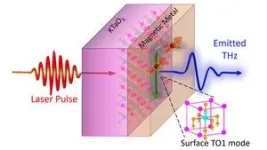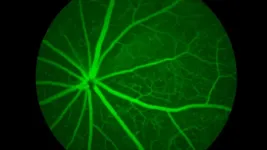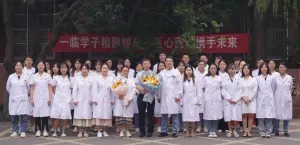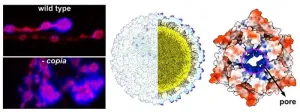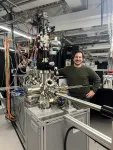(Press-News.org) Scientists are racing to develop new materials for quantum technologies in computing and sensing for ultraprecise measurements. For these future technologies to transition from the laboratory to real-world applications, a much deeper understanding is needed of the behavior near surfaces, especially those at interfaces between materials.
Scientists at the U.S. Department of Energy’s (DOE) Argonne National Laboratory have unveiled a new technique that could help advance the development of quantum technology. Their innovation, surface-sensitive spintronic terahertz spectroscopy (SSTS), provides an unprecedented look at how quantum materials behave at interfaces.
“This technique allows us to study surface phonons — the collective vibrations of atoms at a material’s surface or interface between materials,” said Zhaodong Chu, a postdoctoral researcher at Argonne and first author of the study. “Our findings reveal striking differences between surface phonons and those in the bulk material, opening new avenues for research and applications.”
In materials such as crystals, atoms form repeating patterns called lattices, which can vibrate in waves known as phonons. While much is understood about phonons in the bulk material, little is known about surface phonons — those occurring within nanometers of an interface. The team’s research reveals that surface phonons behave differently, enabling unique quantum behaviors such as interfacial superconductivity.
Superconductivity, the phenomenon of electrons flowing without resistance, has applications in technologies such as MRI machines and particle accelerators. Interfacial superconductivity — a type that appears only at the boundary between two materials — holds promise for new quantum technologies.
“The idea for this discovery began with the finding some years ago that interfaces between two crystalline materials can exhibit superconducting behavior neither one shows on its own,” said Anand Bhattacharya, Argonne physicist.
“It is only when the two materials are together that the superconductivity magic happens at the interface, which is different from the bulk.” added Argonne physicist Haidan Wen.
Believing that a specific type of vibration in the crystal — called the TO1 phonon — triggers this interfacial superconductivity, the team set out to find direct evidence of its role.
There were two main challenges, Wen explained. First, the interface is buried in the sample and only a few nanometers thick, making it hard to study using conventional methods. Second, the team needed to work with terahertz radiation. This happens in a frequency range a thousand times higher than 5G phone networks. Many important quantum effects happen in this terahertz range but capturing them with high resolution is difficult.
The researchers used their SSTS method on samples made by depositing a thin magnetic film onto an oxide crystal. In this method, ultrafast laser pulses pass through the oxide crystal and strike the thin magnetic layer. The interaction between laser light and matter then produces terahertz vibrations at the oxide interface.
By using this technique, the team detected the TO1 phonon. They also showed that the phonon’s behavior within 5 nanometers of the interface differed from the bulk. Surface phonons are like waves in the shallow end of a lake — they behave differently than those in deeper waters.
“Our interface-sensitive technique can be applied to a broad range of materials for probing elusive quantum behavior, including magnetism and superconductivity,” said Michael Norman, Argonne Distinguished Fellow and director of the Argonne Quantum Institute. “We now have a new window into quantum materials that can point the way to novel quantum devices for future technologies.”
Bhattacharya added, “Terahertz light interacting with matter can not only probe quantum materials in new ways, as in our study, but also induce entirely new states of matter. This is an incredibly exciting avenue for future investigation.”
This research was published in Science Advances. In addition to those quoted above, Argonne authors include Junyi Yang, Yan Li, Jianguo Wen, Ashley Bielinski, Qi Zhang, Alex Martinson, Stephan Hruszkewycz and Dillon Fong. Also contributing were Xiaodong Xu and Kyle Hwangbo from the University of Washington.
Funding for the research came from the DOE Office of Basic Energy Sciences. The samples were characterized by terahertz emission spectroscopy in the Materials Science division and by electron microscopy at Argonne’s Center for Nanoscale Materials, a DOE Office of Science user facility.
About Argonne’s Center for Nanoscale Materials
The Center for Nanoscale Materials is one of the five DOE Nanoscale Science Research Centers, premier national user facilities for interdisciplinary research at the nanoscale supported by the DOE Office of Science. Together the NSRCs comprise a suite of complementary facilities that provide researchers with state-of-the-art capabilities to fabricate, process, characterize and model nanoscale materials, and constitute the largest infrastructure investment of the National Nanotechnology Initiative. The NSRCs are located at DOE’s Argonne, Brookhaven, Lawrence Berkeley, Oak Ridge, Sandia and Los Alamos National Laboratories. For more information about the DOE NSRCs, please visit https://science.osti.gov/User-Facilities/User-Facilities-at-a-Glance.
Argonne National Laboratory seeks solutions to pressing national problems in science and technology by conducting leading-edge basic and applied research in virtually every scientific discipline. Argonne is managed by UChicago Argonne, LLC for the U.S. Department of Energy’s Office of Science.
The U.S. Department of Energy’s Office of Science is the single largest supporter of basic research in the physical sciences in the United States and is working to address some of the most pressing challenges of our time. For more information, visit https://energy.gov/science.
END
New nanoscale technique unlocks quantum material secrets
A breakthrough method reveals unique atomic vibrations near interfaces of two materials, paving the way for advanced quantum technologies
2025-02-18
ELSE PRESS RELEASES FROM THIS DATE:
New study uncovers how genes influence retinal aging and brain health
2025-02-18
Vision changes are an inevitable part of aging, but why are some more susceptible to age-related eye diseases and why do some individuals experience more severe decline than others? New research from The Jackson Laboratory (JAX) reveals that genetics play a key role in how the eye ages, with different genetic backgrounds influencing retinal aging in distinct ways.
The study, published in Molecular Neurodegeneration, examined age-related changes in genes and proteins of the retinas of nine strains of mice, ...
‘False’ springs, long summers mean uncertainty for NY grape growers
2025-02-18
CORNELL UNIVERSITY MEDIA RELATIONS OFFICE
FOR RELEASE: Feb. 17, 2025
Kaitlyn Serrao
607-882-1140
kms465@cornell.edu
‘False’ springs, long summers mean uncertainty for NY grape growers
ITHACA, N.Y. – Warmer autumns and more “false” springs are disrupting the signals grapevines rely on to gain cold hardiness for the winter and blossom effectively in the spring, according to new research from Cornell University.
“In New York, we are right at the coldest ...
A treatment-resistant, severe type of asthma successfully modeled in mice
2025-02-18
A better understanding of inflammation and lung immunity over the past two decades has led to new, innovative treatments for asthma, including biologic therapies.
This is especially true for a subtype known as eosinophilic asthma—asthma that’s related to the recruitment and overactivation of white blood cells in the lungs called eosinophils.
However, a different type of asthma called neutrophilic asthma has fewer treatment options and doesn’t respond as well to first line asthma therapy.
As a result, people with this type of asthma, which ...
Cholesterol metabolism byproduct linked to Parkinson’s disease
2025-02-18
Researchers led by Zhentao Zhang at Wuhan University, China have discovered a cholesterol metabolite that plays a critical role in the development of Parkinson’s disease in mice. Published in the open-access journal PLOS Biology on February 18th, the study shows that this metabolite is responsible for the formation of Lewy bodies and the death of dopaminergic neurons in the brain—the two major hallmarks of Parkinson’s disease. Blocking its activity or preventing it from being made by the body could therefore be effective strategies for treating the disease.
Parkinson’s disease develops when the protein alpha-Syn forms clumps of tiny pathological fibers ...
The capsid of the virus-derived retrotransposon Copia, a parasitic genome element, mediates synaptic plasticity at the Drosophila neuromuscular junction
2025-02-18
In your coverage, please use this URL to provide access to the freely available paper in PLOS Biology: https://plos.io/42Ly2Pr
Article title: Capsid transfer of the retrotransposon Copia controls structural synaptic plasticity in Drosophila
Author countries: United States
Funding: This work was supported by NIH Grant R01NS112492 to TT. The funders had no role in study design, data collection and analysis, decision to publish, or preparation of the manuscript. END ...
Sweet molasses feed key to understanding grazing behavior in cattle
2025-02-18
Researchers tempted grazing cattle with sweet molasses feed to discover whether cows would roam far and wide to graze or stick close to the herd, water supplies and feed stations.
The findings by animal scientists at the University of California, Davis, and published in the journal Scientific Reports, offer a low-cost way for ranchers and others to identify the best cows for their landscapes to optimize grazing while meeting the nutritional needs of cattle.
This is the third in a series of papers about research seeking to better understand the grazing personalities of cattle. The first studies ...
Fabio Boschini, first INRS researcher to receive an Alfred P. Sloan Fellowship
2025-02-18
MONTRÉAL and VARENNES, QC, Feb. 18, 2025 /CNW/ - Professor Fabio Boschini is among the 126 recipients announced today by the Alfred P. Sloan Foundation in seven fields. Sloan Fellowships support outstanding early-career scientists who demonstrate creativity, ambition, and dedication to advance discovery. These rising stars of research come from American and Canadian schools and are definitely names to watch. Many Sloan Fellows have gone on to become Nobel prize winners.
INRS Professor Fabio Boschini has just received a prestigious ...
Biomedicine shows the way to future food crops
2025-02-18
University of Queensland researchers have for the first time introduced genetic material into plants via their roots, opening a potential pathway for rapid crop improvement.
Professor Bernard Carroll from UQ’s School of Chemistry and Molecular Biosciences said nanoparticle technology could help fine-tune plant genes to increase crop yield and improve food quality.
“Traditional plant breeding and genetic modification take many generations to produce a new crop variety, which is time-consuming and expensive,” Professor Carroll said.
“We have succeeded in having plant roots absorb a benign nanoparticle which ...
First 5 regions chosen to focus innovative effort on diagnosing, treating CKM syndrome
2025-02-18
DALLAS, Feb. 18, 2025 — Five regions in the U.S. have been selected to implement a new preventive health initiative to improve care for people with a cluster of chronic conditions known as cardiovascular-kidney-metabolic (CKM) syndrome. Through the initiative the American Heart Association, devoted to changing the future to a world of healthier lives for all, aims to increase awareness and screening for CKM syndrome and facilitate collaboration among health care professionals.
CKM syndrome is a clinical term that describes the combined health effects of heart disease, kidney disease, diabetes and obesity, which puts people at high risk for heart ...
Kahramanmaraş earthquake study showcases potential slip rate errors
2025-02-18
Accurate assessment of the land surface damage (such as small-scale fracturing and inelastic deformation) from two major earthquakes in 2023 can help scientists assess future earthquake hazards and therefore minimize risk to people and infrastructure. However, attaining precise extensive measurements in earthquake zones remains challenging.
The two earthquakes that struck on 6 February 2023 were devastating: they were of magnitude 7.8 and 7.6 and occurred in quick succession near the border between Syria and Turkey. They caused widespread infrastructure destruction and resulted in tens of thousands of deaths across multiple provinces.
Using ...
LAST 30 PRESS RELEASES:
Scalable and healable gradient textiles for multi‑scenario radiative cooling via bicomponent blow spinning
Research shows informed traders never let a good climate crisis go to waste
Intelligent XGBoost framework enhances asphalt pavement skid resistance assessment
Dual-function biomaterials for postoperative osteosarcoma: Tumor suppression and bone regeneration
New framework reveals where transport emissions concentrate in Singapore
NTP-enhanced lattice oxygen activation in Ce-Co catalysts for low-temperature soot combustion
Synergistic interface engineering in Cu-Zn-Ce catalysts for efficient CO2 hydrogenation to methanol
COVID-19 leaves a lasting mark on the human brain
Scientists use ultrasound to soften and treat cancer tumors without damaging healthy tissue
Community swimming program for Black youth boosts skills, sense of belonging, study finds
Specific depressive symptoms in midlife linked to increased dementia risk
An ‘illuminating’ design sheds light on cholesterol
Who is more likely to get long COVID?
Study showcases resilience and rapid growth of “living rocks”
Naval Research Lab diver earns Office of Naval Research 2025 Sailor of the Year
New Mayo-led study establishes practical definition for rapidly progressive dementia
Fossil fuel industry’s “climate false solutions” reinforce its power and aggravate environmental injustice
Researchers reveal bias in a widely used measure of algorithm performance
Alcohol causes cancer. A study from IOCB Prague confirms damage to DNA and shows how cells defend against it
Hidden viruses in wastewater treatment may shape public health risks, study finds
Unlock the power of nature: how biomass can transform climate mitigation
Biochar reshapes hidden soil microbes that capture carbon dioxide in farmland
Reducing saturated fat intake shows mortality benefit, but only in high-risk individuals
Manta rays create mobile ecosystems, study finds
Study: Mixed results in using lipoic acid to treat progressive multiple sclerosis
Norbert Holtkamp appointed director of Fermi National Accelerator Laboratory
New agentic AI platform accelerates advanced optics design
Biologists discover neurons use physical signals — not electricity — to stabilize communication
Researchers discover that a hormone can access the brain by hitchhiking
University of Oklahoma researcher awarded funding to pursue AI-powered material design
[Press-News.org] New nanoscale technique unlocks quantum material secretsA breakthrough method reveals unique atomic vibrations near interfaces of two materials, paving the way for advanced quantum technologies

